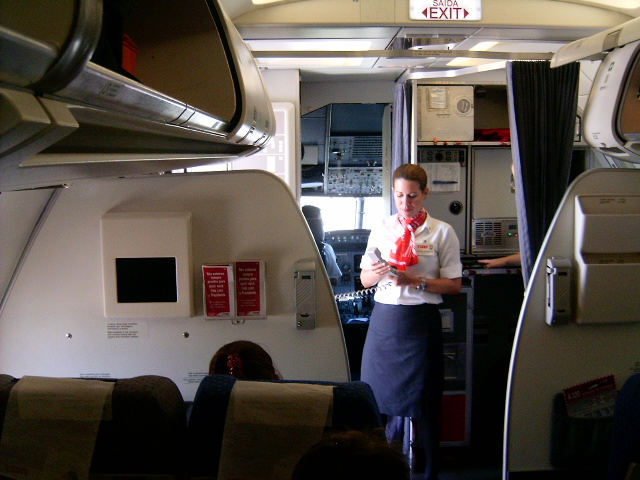You are probably going to have to sit next to someone creepy if you travel on public transit long enough. All of us,however, try to avoid this by giving off unspoken cues to potential seatmates so they move along and sit next to some other unlucky soul. In this piece Stephanie Medley-Rath recounts a recently perilous travel experience and explains how it illustrates what sociologists call openings and closings.

I was panicking. My eyes darted from side-to-side as I walked down the narrow aisle dividing the parallel rows of three blue seats on the Southwest Airplane that was taking my family home. “Every damn one of them, Geeze!” I screamed quietly under my breath. Row after row of seats were filled by a single passenger in the window seat and another in the aisle. My mouth dried at the social awkwardness of having to ask someone to move. You see, I was traveling with my preschool aged daughter and I’d be damned before I’d have her sit between strangers.
Finally one of the last rows toward the back of the plane was empty. A sense of relief wafted over me as my husband, daughter, and I buckled our seat belts.
“But wait, didn’t you have assigned seats?” you may be asking right now. No, we didn’t. On Southwest Airlines unlike other airlines, you are assigned to a boarding group, not an assigned seat. After that it’s a first-come-first-serve sit where you like kinda thing. Passengers jockey for position at the gate and when they announce your boarding group over the loud speaker it can turn into a kill or be killed dash down jetway to the plane entrance.
The social awkwardness of boarding doesn’t end there. Even if you manage to secure an acceptable seat, you then have to watch as those less fortunate negotiate their seating arrangement. Sure, it sounds like no biggie, it becomes excruciating as passenger after passenger comes to the realization that they will be traveling pressed between Johnny-music-blarring-through-headphones and Sally-skipped-her-shower.
Typically, a flight attendant will make an announcement that all the seats that are left are the middle seats, subtly encouraging people to just sit in the first empty seat he or she can find. When the passenger desperation was reaching it’s zenith the intercom first buzzed and then a distorted voice filled the cabin. “Good morning ladies and gentlemen, my name is Brenda [not her real name] and I’d like to welcome you to Flight 162 with service to Dallas.” Brenda’s tone pivoted to a sarcastic one as she continued, “At this time all of the aisle and window seats have been taken, but somehow the middle seat is available in nearly every row, huh? Please find one and take your seat as quickly as possible. At this time I’d also like all of the passengers who are already seated to quit avoiding eye contact with your fellow passengers who have yet to be seated.” A laugh blurted out of my mouth before my hand could cover my lips. I was not alone in laughing nor, apparently, was I the only one who was avoiding eye contact.
Eye contact is often the first step in communicating with someone else. Symbolic-interactionists point out that we use “openings” to begin an interaction and “closings” to end it. Openings include everything from saying hello, waving, or clearing our throats with an ahem to get someone’s attention. Closings might include saying good-bye, standing up and moving toward the exit, or saying things like, “This was fun, we should do it again sometime soon.” These verbal and non-verbal cues help us navigate discussions and save us from having to be rude and say, “I’m done talking with you, kick rocks!”
Back to the plane. Eye contact is perhaps the most common form of an opening. When people walk down the aisle you avoid eye contact because the implication is that eye contact communicates that you are open to having someone sit next to you. Eye contact is a gesture that we use to communicate. The hilarious flight attendant’s point was that the plane will be full and someone will sit next to you no matter what form of nonverbal communication you give off to discourage someone from sitting next to you.
Airplanes are not the only spaces where avoiding eye contact means something in terms of where passengers sit. Esther Kim recently published her sociological research on travel norms of Greyhound passengers finding that Greyhound passengers also avoid eye contact, among other nonverbal cues, to prevent passengers from becoming seatmates.
So the next time you’re on a Southwest flight, keep an eye out for people keeping their eyes down. (Do you see what I did there? That last sentence is similar to a closing. I am communicating that I am done talking with you.)
Dig Deeper:
- How do you decide where to sit in public spaces? What cues besides eye contact to you consider when deciding where to sit?
- Come up with a list of five openings and five closings that we use in conversations everyday. Please don’t use any discussed in this article.
- What nonverbal cues do you give others to encourage or discourage them from sitting next to you?
- Read about Ester Kim’s Greyhound study here. Can you think of other public spaces where people want to be left alone? Are the norms of “civil inattention” evident in this space? Why or why not?